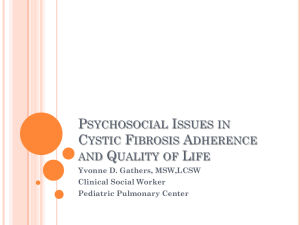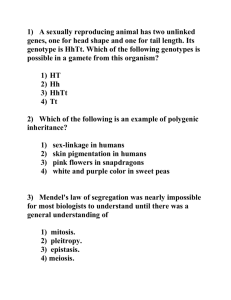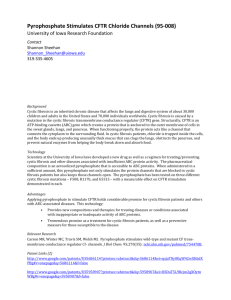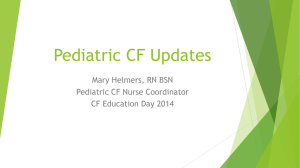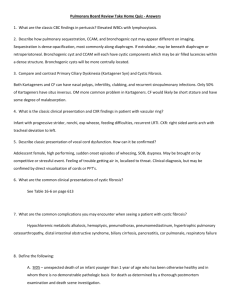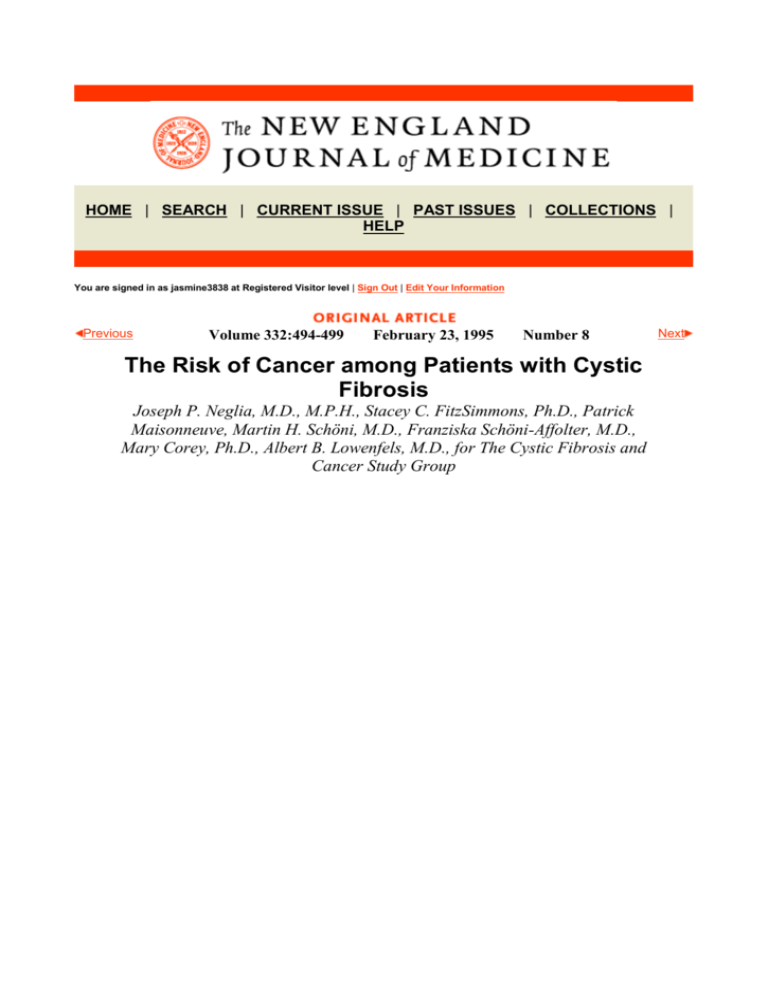
HOME | SEARCH | CURRENT ISSUE | PAST ISSUES | COLLECTIONS |
HELP
You are signed in as jasmine3838 at Registered Visitor level | Sign Out | Edit Your Information
Previous
Volume 332:494-499
February 23, 1995
Number 8
The Risk of Cancer among Patients with Cystic
Fibrosis
Joseph P. Neglia, M.D., M.P.H., Stacey C. FitzSimmons, Ph.D., Patrick
Maisonneuve, Martin H. Schöni, M.D., Franziska Schöni-Affolter, M.D.,
Mary Corey, Ph.D., Albert B. Lowenfels, M.D., for The Cystic Fibrosis and
Cancer Study Group
Next
ABSTRACT
Background Anecdotal reports suggest an
increased frequency of certain cancers in
patients with cystic fibrosis, the commonest
genetic disorder of whites. One third of
patients with cystic fibrosis now reach
adulthood, when cancer is more frequent,
implying that cancer rates in these patients will
increase over time. We investigated the
relation between cystic fibrosis and cancer in
North American and European patients with
cystic fibrosis.
Methods We performed a retrospective cohort
study of the occurrence of cancer in 28,511
patients with cystic fibrosis from 1985 through
1992 in the United States and Canada. The
number of cases observed was compared with
the number expected, calculated from
population-based data on the incidence of
cancer. We also analyzed proportional
incidence ratios to assess the association
between specific cancers and cystic fibrosis in
Europe.
Table of Contents
Abstract of this
article
PDF of this article
Related Letters to the
Editor
Find Similar Articles
in the Journal
Articles citing this
article
Add to Personal
Archive
Download to Citation
Manager
Alert me when this
article is cited
Related Articles in
Medline
Articles in Medline by Author:
Neglia, J. P.
Results Thirty-seven cancers were observed
in the North American cohort during 164,764
Medline Citation
person-years of follow-up, as compared with
an expected number of 45.6, yielding a ratio of observed to expected cancers
of 0.8 (95 percent confidence interval, 0.6 to 1.1). Thirteen digestive tract
tumors were observed, as compared with an expected number of two, for a
ratio of observed to expected cancers of 6.5 (95 percent confidence interval,
3.5 to 11.1). In Europe, 11 of 39 cancers originated in the digestive tract,
yielding a positive association between digestive tract tumors and cystic
fibrosis (odds ratio, 6.4; 95 percent confidence interval, 2.9 to 14.0).
Conclusions Although the overall risk of cancer in patients with cystic fibrosis
is similar to that of the general population, there is an increased risk of
digestive tract cancers. Persistent or unexplained gastrointestinal symptoms in
these patients should be carefully investigated.
Cystic fibrosis is the commonest recessive genetic disease of whites. About 2 to 4
percent of all white persons carry the gene for cystic fibrosis, and there are
approximately 25,000 patients with this disease in the United States.1 The disease has
a broad range of symptoms, including meconium ileus, recurrent suppurative lung
infection, sinusitis, and pancreatic insufficiency.
Because of improved care, the life span of patients with cystic fibrosis is increasing.
In the United States, the median survival of these patients doubled between 1969 and
1990; one third of all patients now attain adulthood.1 With increasing survival, a
predisposition to cancer, previously obscured by the short life span of these patients,
may become evident.
Previous reports suggested that patients with cystic fibrosis may have an increased
risk of cancer, particularly digestive tract cancers and leukemia.2,3,4,5,6,7,8,9,10,11,12,13,14,15
To evaluate this risk, we conducted a retrospective cohort study of the occurrence of
cancer in more than 25,000 patients with cystic fibrosis who were followed at centers
in the United States or Canada, and we studied the distribution of cancer in more than
18,000 patients with cystic fibrosis from 17 European countries.
Methods
U.S. and Canadian Cohorts
Patients
The incidence of cancer in two cohorts of patients with cystic fibrosis was analyzed.
The U.S. cohort consisted of all patients with cystic fibrosis who were registered and
followed between 1985 and 1992 at any of 115 centers in the United States accredited
by the Cystic Fibrosis National Foundation (see the Appendix). This registry currently
includes nearly 20,000 living patients, representing 80 percent of the estimated 25,000
patients with cystic fibrosis in the United States.1
The Canadian cohort was obtained from the Canadian Cystic Fibrosis Foundation
Registry, which includes nearly 3000 patients in 33 centers, representing over 95
percent of Canadian patients with cystic fibrosis.
Reporting of Cancers
All U.S. and Canadian centers responded to a questionnaire requesting the number of
incident cancers that had occurred between January 1, 1985, and December 31, 1992.
Information supplied included the patient's date of birth, sex, and race; date of
diagnosis of the cancer; type and location of tumor and histologic verification; and
vital status.
Statistical Analysis
To calculate the number of cancers expected, the period during which patients were at
risk was defined as the time from the organization of the cohort to death or to the end
of the calendar year in which a patient visited a cystic fibrosis center. The time at risk
for patients born after the establishment of the cohort began at that person's birth date.
Two starting dates were chosen: January 1, 1985, and January 1, 1988. The first was
chosen because the U.S. Cystic Fibrosis Registry was standardized as of that year. The
second was chosen to exclude potential underreporting of cases in the earliest years of
the study, while still allowing a five-year period of ascertainment. Data on all persons
alive and actively followed were censored as of December 31, 1992. Data on persons
reported as not seen during a calendar year or reported as lost to follow-up during that
year were censored as of the end of the previous year.
The number of cancers expected during both at-risk periods was determined by
applying age-, sex-, and race-specific incidence rates from the Surveillance,
Epidemiology, and End Results (SEER) Program of the National Cancer Institute for
1984 to 1988 to the total person-years accumulated in the corresponding categories
(five-year blocks).16 Because of the similarities of the cohorts and cancer rates in the
United States and Canada, person-years accumulated by both the Canadian and U.S.
cohorts were pooled. Ninety-five percent confidence intervals for the ratio of the
number of cancers observed to the number expected were calculated on the basis of a
Poisson model.17
For both periods, we calculated the expected number of all cancers as well as the
expected numbers of three subgroups of cancer: digestive tract cancers, leukemias and
lymphomas, and all other tumors. We also calculated the numbers of cancers expected
for the following groups: 9 years of age and younger, 10 to 19 years, 20 to 29 years,
30 to 39 years, and 40 years and older.
Case–Control Study
We conducted an exploratory case–control study matching North American patients
with cystic fibrosis who had cancer to a maximum of four patients with cystic fibrosis
who were cancer-free. The patients were matched for age (within three years), sex,
race, and center. Patients older than 40 years were matched for age within five years.
The chi-square test was used to determine statistical significance.
European Cohorts
Patients
From data bases maintained by European cystic fibrosis organizations, we compiled a
list of 377 centers or physicians who treat patients with cystic fibrosis in 17 European
countries. The countries included in the study, and the estimated numbers of patients
with cystic fibrosis in each country in 1992 as reported to the International Cystic
Fibrosis Association, were as follows: Austria, 500; Belgium, 600; Denmark, 330;
France, 5500; Germany, 3850; Hungary, 450; Iceland, 6; Ireland, 1000; Italy, 2400;
the Netherlands, 800; Norway, 210; Romania, 120; Spain, 1510; Sweden, 350;
Switzerland, 800; and the United Kingdom, 6000. For Finland, the estimated number
of patients with cystic fibrosis was less than 100. The number of patients under
treatment in these 17 countries was approximately 24,500.
The North American survey questionnaire was mailed to all identified physicians or
treatment centers. Responses were received from physicians treating approximately
two thirds of all patients with cystic fibrosis in the 17 study countries (see the
Appendix). For the United Kingdom, Italy, Germany, Sweden, and Denmark, the
overall rate of response was 88 percent. The study period extended from January 1,
1982, through March 1, 1994.
Statistical Analysis
Because there was no well-defined cohort of European patients with cystic fibrosis,
we used proportional incidence ratios to measure the association between cystic
fibrosis and any particular type of cancer. The data were analyzed as if arising from a
case–control study in which the reference population included all patients with cancer,
with cystic fibrosis as the exposure variable.18 Case patients with cystic fibrosis were
defined as patients with tumors of the types under study; controls with cystic fibrosis
were identified as patients with other types of cancer. Case patients and controls
without cystic fibrosis were obtained from published data on the incidence of cancer
according to age, sex, and country.19 If the odds ratio indicated an association between
any particular type of cancer and cystic fibrosis, patients with that type of cancer were
then excluded from both the group with cystic fibrosis and the referent group before
an analysis was performed for other types of cancer. Logistic-regression analysis was
used to calculate a summary odds ratio and 95 percent confidence interval for each
type of cancer, adjusted for age (in five-year increments), sex, and country.
Since all cancers included in the final study occurred during or after 1982, recent
country-specific data on the incidence of cancer in Europe were used to obtain the
number of cases occurring in case patients and controls without cystic fibrosis.19 For
Austria, we substituted data from Switzerland. Non-melanoma skin cancers were
excluded from the comparison group without cystic fibrosis. For countries with more
than one cancer registry, all reported cases of cancer from individual registries were
combined.
For both Europe and North America, the International Classification of Diseases, 9th
Revision, Clinical Modification (ICD-9-CM) was used to classify cancers into various
groups.
Results
North American Study
Characteristics of the Cohort
During the study period, 28,511 patients with cystic fibrosis were reported to the U.S.
and Canadian cystic fibrosis registries. Of these, 15,161 were male (53.2 percent) and
13,350 were female (46.8 percent). Ninety-five percent of the cohort was described as
white and 2.8 percent as black. The age at entry into the cohort ranged from birth to
64 years (median, 7).
From January 1, 1985, to December 31, 1992, a total of 164,764 person-years of
follow-up was recorded. For the five-year period from January 1, 1988, to December
31, 1992, 24,869 persons contributed a total of 103,916 person-years of follow-up.
Reported Cancers
Between 1985 and 1992, 41 cancers were reported in the North American cohort. Four
cancers that were not reportable on the basis of SEER data were excluded from the
analysis: three carcinomas in situ and one basal-cell skin cancer. Thus, the study
included 37 histologically confirmed cancers (32 in the United States and 5 in Canada)
(Figure 1). These consisted of 13 digestive tract cancers (esophagus, 1; stomach, 1;
small intestine, 2; large intestine, 3; liver or biliary tract, 5; and pancreas, 1), 8 cases
of leukemia and lymphoma (including 1 post-transplantation lymphoma), 5 central
nervous system tumors, 4 testicular cancers, 2 cervical cancers, 2 breast cancers, 1
cancer of the tongue, 1 cancer of the thigh (rhabdomyosarcoma), and 1 malignant
melanoma. All cancers occurred in white patients. Table 1 and Table 2 and Figure 1
compare the demographic characteristics of the patients and the distribution of cancer
among the North American and European groups.
Figure 1. Cancers among 76 Patients with Cystic
Fibrosis, According to the Patient's Age at Diagnosis
of the Cancer, Sex, Type of Tumor, and Geographic
Location.
The diamonds denote digestive tract cancers (ICD-9CM codes 150 to 159), circles hematopoietic cancers
(ICD-9-CM codes 200 to 208), and plus signs all
other types of tumors.
View larger version (4K):
[in this window]
[in a new window]
View this
table:
[in this
window]
[in a new
window]
View this
table:
[in this
window]
[in a new
window]
Table 1. Comparison of North American and European Patients
with Cystic Fibrosis and Cancer.
Table 2. Distribution of Cancer in 37 North American and 39
European Patients with Cystic Fibrosis, According to Age, Sex, and
Type of Tumor.
Ratios of Observed to Expected Cases
From 1985 to 1992, a total of 45.6 cancers would have been expected in the North
American cohorts with cystic fibrosis, on the basis of age-, sex-, and race-specific
SEER rates (Table 3). Thirty-seven cancers were reported, yielding a ratio of observed
to expected cases of 0.8 (95 percent confidence interval, 0.6 to 1.1). For digestive tract
cancer, the ratio of observed to expected cases was 6.5 (95 percent confidence
interval, 3.5 to 11.1). For leukemias and lymphomas, the ratio of observed to expected
cases was 0.7 (95 percent confidence interval, 0.3 to 1.3). For all other tumors (after
the exclusion of digestive tract cancers, leukemias, and lymphomas), the ratio of
observed to expected cases was 0.5 (95 percent confidence interval, 0.3 to 0.8).
View this
table:
[in this
window]
[in a new
window]
Table 3. Number of Cancers Observed and the Number Expected
among North American Patients with Cystic Fibrosis.
To determine whether the risk of cancer increases with age, the number of cases
observed and the number expected in the North American cohort were calculated for
five age groups (0 to 9 years, 10 to 19 years, 20 to 29 years, 30 to 39 years, and >40
years) for the full cohort (1985 to 1992). The age-specific ratios of observed to
expected cases for all cancers were as follows: 0 to 9 years, 0.4 (95 percent confidence
interval, 0.1 to 1.03); 10 to 19 years, 0.49 (95 percent confidence interval, 0.1 to 1.3);
20 to 29 years, 1.0 (95 percent confidence interval, 0.5 to 1.7); 30 to 39 years, 1.2 (95
percent confidence interval, 0.6 to 2.1); and >40 years, 0.9 (95 percent confidence
interval, 0.3 to 2.1). A marked elevation of the risk ratio for digestive tract tumors was
seen for the age range of 20 to 29 years (ratio of observed to expected cases, 23.2; 95
percent confidence interval, 10.6 to 44.0).
Because of possible underreporting of all cancers in the earliest years of the study, the
number of cases observed and the number expected were also analyzed for the most
recent five-year period for which data were available (January 1988 through
December 1992). During this period, 29 cancers were observed and 29.8 were
expected (ratio of observed to expected cases, 0.97; 95 percent confidence interval,
0.7 to 1.4). No change was seen in the ratio of observed to expected cases of digestive
tract cancer: 9 were observed and 1.36 were expected, yielding a ratio of 6.6 (95
percent confidence interval, 3.0 to 12.6). The statistically significant deficit of other
types of cancers observed in the full cohort disappeared. No significant difference was
noted between sexes in the pattern of observed and expected cases of cancer.
Case–Control Study
Exploratory analysis of the 37 case patients and 131 matched controls in the North
American cohort did not suggest any characteristics associated with an increased risk
of cancer (P>0.10). The variables assessed included the age at diagnosis of cystic
fibrosis; presenting signs and symptoms of cystic fibrosis, such as steatorrhea,
malnutrition, meconium ileus, rectal prolapse, and liver disease; and subsequent
clinical characteristics, such as malnutrition, decreased lung function, pancreatic
insufficiency, cirrhosis, diabetes, distal bowel obstruction, rectal prolapse, and
pancreatitis.
European Study
From January 1982 through March 1994, 41 patients with cystic fibrosis were given a
diagnosis of cancer in the European centers (Figure 1). Two patients were excluded:
one with non-melanoma skin cancer and one with carcinoma in situ of the cervix. The
following countries contributed 1 or more patients to the study: the United Kingdom,
12; Italy, 10; Germany, 7; France, 3; Sweden, 2; Denmark, 2; and Austria, Hungary,
and Spain, 1 each. The diagnosis of cancer was confirmed histologically in all but two
patients, one with a clinical diagnosis of neuroblastoma and another with a diagnosis
of a craniopharyngioma. Eleven of the 39 cancers (28 percent) originated in the
digestive tract: 1 in the esophagus, 1 in the small intestine, 6 in the large intestine, 2 in
the pancreas, and 1 in the retroperitoneum.
Analysis of the European data yielded findings similar to those of the North American
study (Table 4). For digestive tract cancers the odds ratio was significantly elevated
(odds ratio, 6.4; 95 percent confidence interval, 2.9 to 14.0). Significant associations
were found for cancer of the esophagus, cancer of the small and large intestine, and
cancer of the pancreas. For subjects who were 20 to 29 years of age, the odds ratio for
all digestive tract cancers was 20.2 (95 percent confidence interval, 6.1 to 67). The
single case of multiple myeloma and the three endocrine tumors were also statistically
associated with cystic fibrosis. No significant association was found for the broader
group of lymphatic and hematopoietic neoplasms (ICD-9-CM codes 200 to 208) or for
the miscellaneous other tumors (odds ratio, 1.4 and 0.7, respectively).
View this
table:
[in this
window]
[in a new
window]
Table 4. Association between Cystic Fibrosis and Various Types of
Cancer in European Patients.
Genotype Information
Genotype information was available for 21 patients (15 European and 6 North
American). Fourteen patients (67 percent) were homozygous for the F508 mutation.
Discussion
In this study of more than 38,000 persons with cystic fibrosis, there is clear evidence
of an excess of digestive tract cancers and no evidence of an increased risk of any
other cancers. The digestive tract cancers included cancers of the esophagus, stomach,
small and large intestine, colon, liver, biliary tract, pancreas, and rectum. Many of
these patients were only in their third decade at the time of the diagnosis of cancer.
There have been only two other analyses of the risk of cancer in cystic fibrosis. One
study of 712 patients with cystic fibrosis did not show an excess risk,14 but another
report involving 412 patients demonstrated a significant excess of pancreatic and
small-intestine cancers.15
Our data show an excess of cancer in an organ system known to be disrupted by the
cystic fibrosis disease process. Organ-specific risks of cancer may be associated with
the differential localization and expression of the cystic fibrosis transmembrane
conductance regulator (CFTR) gene. High levels of CFTR expression, which are
maintained throughout life, are found in many fetal and adult digestive tissues, such as
pancreatic ducts, bile ducts, gallbladder epithelium, and intestinal crypts.20,21 In
contrast, the expression of CFTR in respiratory tissue, although present in primordial
lung epithelia, is greatly reduced at birth; in adult respiratory epithelia, the expression
of CFTR is localized to the serous submucosal glands and a few cells in gland ducts,
with little expression in other respiratory epithelia.22,23,24,25 Furthermore, the response
of different organ systems to the absence of CFTR function appears to vary.
Therefore, the differential risk of cancer in various organs may be partly explained by
the level of CFTR expression and by varying sensitivities of individual organs.
Another possible explanation for our findings is that the excess risk of digestive tract
cancer is caused by the effect of the cystic fibrosis disease process on digestive tract
organs. Barrett's syndrome, a disease known to be associated with esophageal cancer,
has been reported in patients with cystic fibrosis.26 Hepatobiliary tract cancers often
occur in patients with gallstones, and gallstones are frequently found in patients with
cystic fibrosis.27 Persistent pathologic alterations in digestive tract organs, leading to
increased cell turnover, might explain the excess risk of digestive tract cancer. Also,
patients with cystic fibrosis frequently have steatorrhea, which has been linked to
small-bowel cancer in patients with celiac disease.28 Patients with cystic fibrosis and
persistent malabsorption have also been found to have deficiencies of the antioxidants
selenium and vitamin E, which may offer some protection from cancer.29,30
Despite the excess number of digestive tract cancers, the total number of cancers was
not increased. Warren and coworkers suggested that the cystic fibrosis gene may
protect against some tumors, such as melanoma.31 However, even with the large
numbers of patients and person-years included in the North American study, the small
numbers of expected cancers limited our ability to detect minor age-specific or sitespecific changes in the frequency of cancer. Prospective ascertainment of cancers over
longer periods in these cohorts will be necessary to determine whether there are any
other excesses or deficits.
Genetic data were only available for 21 of the 76 study patients with cancer. In this
small group, the frequency of the F508 mutation was similar to that in cancer-free
patients with cystic fibrosis.32 More detailed genotypic analysis, including an
examination of genes known to be associated with the risk of cancer, could yield
potentially useful information.
There are several potential sources of bias in this study. The European study depended
on the ability of physicians to report information about patients with cancer over a 12year period. An apparent excess of digestive tract tumors would be observed if
physicians were more likely to remember and report digestive tract tumors and to
overlook non–digestive tract tumors. Such a differential bias seems unlikely, since the
findings were nearly identical in the North American cohort. Five patients with cancer
in the European series, including three with digestive tract tumors, were previously
included in a cohort study. When these patients were excluded, the excess risk of
digestive tract cancer persisted (odds ratio, 5.8; 95 percent confidence interval, 2.4 to
14.0).
The European study could be biased by an excess of non–digestive tract tumors in
countries with a low response rate. Thirty-three of 39 cancers were reported from the
United Kingdom, Italy, Germany, Sweden, and Denmark. When we restricted the
analysis to these countries, where the overall rate of response was 88 percent, the
excess risk of digestive cancer persisted (odds ratio, 6.7; 95 percent confidence
interval, 2.9 to 15.4).
The risk of digestive tract cancers might have been overestimated in the North
American cohort if cancer-free adult patients with cystic fibrosis were more likely to
be lost to follow-up. Data from the U.S. Cystic Fibrosis Foundation show that
approximately 600 persons are lost to follow-up each year at a median age of 16 years.
Given this, the expected number of total cancers could be expected to increase by less
than one case. It is also possible that occult cancers were missed in living patients
because of the severity of cystic fibrosis and the similarity of the gastrointestinal
symptoms of cancer and cystic fibrosis; if so, our results are conservatively biased.
Finally, for both the North American and European studies, increased surveillance
might have led us to detect more cancers in the patients than are detected in the
general population. This seems unlikely since the elevated risk of cancer was
restricted to a single organ system, with no apparent overall increase in the risk of
cancer.
Despite these possible biases, it appears that cystic fibrosis can be added to the
growing list of genetic defects that are related to cancer. As the life span of patients
with cystic fibrosis increases, more digestive tract cancers will occur. Although cancer
will continue to be an uncommon diagnosis for patients with cystic fibrosis, the
increased risk of digestive tract cancer in these patients suggests that persistent or
unexplained gastrointestinal symptoms deserve careful investigation.
Supported by funds from the Children's Cancer Research Fund of the University of Minnesota; the
Cystic Fibrosis Foundation, Bethesda, Md.; Kali-Chemie AG, Hannover, Germany; the European
Working Group for Cystic Fibrosis; the International Cystic Fibrosis Foundation; and Solvay
Pharmaceuticals, Inc., Marietta, Ga.
We are indebted to Professor John A. Dodge and Susan Morison, United Kingdom Cystic Fibrosis
Survey, for supplying information about cases in the United Kingdom; to Cathleen Morrison and Ian
McIntosh, Canadian Cystic Fibrosis Foundation, for collecting information about the Canadian cases;
to Michelle Roche, International Cystic Fibrosis Association, for help with the European data; to
Kenneth J. Rothman, Ph.D., for suggestions about the analysis of the European study; to Drs. John D.
Potter and Garry R. Cutting for their review of the manuscript; and to Nancy A. Riekert and Doris B.
Lowenfels for management of the data base.
*
In addition to the authors, the members of the Cystic Fibrosis and Cancer Study Group included Peter
Boyle, Ph.D., European Institute of Oncology, Milan, Italy; Allen J. Dozor, M.D., New York Medical
College, Valhalla; and Peter Durie, M.D., Hospital for Sick Children, Toronto.
Source Information
From the Departments of Pediatrics and Epidemiology, University of Minnesota Schools of Medicine
and Public Health, Minneapolis (J.P.N.); the Cystic Fibrosis Foundation, Bethesda, Md. (S.C.F.); the
Division of Epidemiology and Biostatistics, European Institute of Oncology, Milan, Italy (P.M.);
Alpine Children's Hospital, Davos Platz, Switzerland (M.H.S., F.S.-A.); the Hospital for Sick Children,
Toronto (M.C.); and the Departments of Surgery and Community and Preventive Medicine, New York
Medical College, Valhalla (A.B.L.).
Address reprint requests to Dr. Lowenfels at the Department of Surgery, New York Medical College,
Valhalla, NY 10595.
References
1. FitzSimmons SC. The changing epidemiology of cystic fibrosis. J Pediatr
1993;122:1-9.[Medline]
2. McIntosh JC, Schoumacher RA, Tiller RE. Pancreatic adenocarcinoma in a
patient with cystic fibrosis. Am J Med 1988;85:592-592.[Medline]
3. Davis TH, Sawicka EH. Adenocarcinoma in cystic fibrosis. Thorax
1985;40:199-200.[Medline]
4. Tedesco FJ, Brown R, Schuman BM. Pancreatic carcinoma in a patient with
cystic fibrosis. Gastrointest Endosc 1986;32:25-26.[Medline]
5. Redington AN, Spring R, Batten JC. Adenocarcinoma of the ileum presenting
as non-traumatic clostridial myonecrosis in cystic fibrosis. BMJ
1985;290:1871-1872.[Medline]
6. Siraganian PA, Miller RW, Swender PT. Cystic fibrosis and ileal carcinoma.
Lancet 1987;2:1158-1158.
7. Roberts JA, Tullett WM, Thomas JS, Galloway D, Stack BHR. Bowel
adenocarcinoma in a patient with cystic fibrosis. Scott Med J 1986;31:109109.[Medline]
8. Abdul-Karim FW, King TA, Dahms BB, Gauderer MWL, Boat TF.
Carcinoma of extrahepatic biliary system in an adult with cystic fibrosis.
Gastroenterology 1982;82:758-762.[Medline]
9. Miller RW. Childhood cancer and congenital defects: a study of U.S. death
certificates during the period 1960-1966. Pediatr Res 1969;3:389397.[Medline]
10. Cole WQ, Pullen J. Cystic fibrosis with acute myelogenous leukemia. In:
Cystic Fibrosis Club abstracts, Atlantic City, N.J., April 29, 1970. Atlanta:
Cystic Fibrosis Foundation, 1970:33.
11. Biggs BG, Vaughan W, Colombo JL, Sanger W, Purtilo DT. Cystic fibrosis
complicated by acute leukemia. Cancer 1986;57:2441-2443.[Medline]
12. Moss RB, Blessing-Moore J, Bender SW, Weibel A. Cystic fibrosis and
neuroblastoma. Pediatrics 1985;76:814-817.[Abstract]
13. Gorvoy JD. A malignant tumor associated with cystic fibrosis. In: Abstracts of
the 22nd Annual Meeting of the Cystic Fibrosis Club, San Francisco, Calif.,
May 1, 1981. Rockville, Md.: Cystic Fibrosis Foundation, 1981:117.
14. Neglia JP, Wielinski CL, Warwick WJ. Cancer risk among patients with cystic
fibrosis. J Pediatr 1991;119:764-766.[Medline]
15. Sheldon CD, Hodson ME, Carpenter LM, Swerdlow AJ. A cohort study of
cystic fibrosis and malignancy. Br J Cancer 1993;68:1025-1028.[Medline]
16. Ries LAG, Hankey BF, Miller BA, Hartman AM, Edwards BK. Cancer
statistics review 1973-1988. Washington, D.C.: Government Printing Office,
1991. (NIH publication no. 91-2789.)
17. Bailar JC III, Ederer F. Significance factors for the ratio of a Poisson variable
to its expectation. Biometrics 1964;20:639-643.
18. Rothman KJ. Modern epidemiology. Boston: Little, Brown, 1986:73-4.
19. Parkin DM, Muir CS, Whelan SL, Gao YT, Ferlay J, Powell J, eds. Cancer
incidence in five continents. Vol. VI. Lyon, France: International Agency for
Research on Cancer, 1992. (IARC scientific publications no. 120.)
20. Tizzano EF, Chitayat D, Buchwald M. Cell-specific localization of CFTR
mRNA shows developmentally regulated expression in human fetal tissues.
Hum Mol Genet 1993;2:219-224.[Abstract]
21. Trezise AE, Chambers JA, Wardle CJ, Gould S, Harris A. Expression of the
cystic fibrosis gene in human foetal tissues. Hum Mol Genet 1993;2:213218.[Abstract]
22. McCray PB Jr, Wohlford-Lenane CL, Snyder JM. Localization of cystic
fibrosis transmembrane conductance regulator mRNA in human fetal lung
tissue by in situ hybridization. J Clin Invest 1992;90:619-625.[Medline]
23. Tizzano EF, O'Brodovich H, Chitayat D, Benichou JC, Buchwald M. Regional
expression of CFTR in developing human respiratory tissues. Am J Respir
Cell Mol Biol 1994;10:355-362.[Abstract]
24. Engelhardt JF, Yankaskas JR, Ernst SA, et al. Submucosal glands are the
predominant site of CFTR expression in the human bronchus. Nat Genet
1992;2:240-248.[Medline]
25. Engelhardt JF, Zepeda M, Cohn JA, Yankaskas JR, Wilson JM. Expression of
the cystic fibrosis gene in adult human lung. J Clin Invest 1994;93:737749.[Medline]
26. Hassall E, Israel DM, Davidson AGF, Wong LTK. Barrett's esophagus in
children with cystic fibrosis: not a coincidental association. Am J
Gastroenterol 1993;88:1934-1938.[Medline]
27. Tesluk H, McCauley K, Kurland G, Ruebner BH. Cholangiocarcinoma in an
adult with cystic fibrosis. J Clin Gastroenterol 1991;13:485-487.[Medline]
28. Swinson CM, Slavin G, Coles EC, Booth CC. Coeliac disease and
malignancy. Lancet 1983;1:111-115.[Medline]
29. Stead RJ, Redington AN, Hinks LJ, Clayton BE, Hodson ME, Batten JC.
Selenium deficiency and possible increased risk of carcinoma in adults with
cystic fibrosis. Lancet 1985;2:862-863.[Medline]
30. Bostick RM, Potter JD, McKenzie DR, et al. Reduced risk of colon cancer
with high intake of vitamin E: the Iowa Women's Health Study. Cancer Res
1993;53:4230-4237.[Abstract]
31. Warren N, Holmes JA, al-Jader L, West RR, Lewis DC, Padua RA. Frequency
of carriers of cystic fibrosis gene among patients with myeloid malignancy
and melanoma. BMJ 1991;302:760-761.[Medline]
32. The Cystic Fibrosis Genotype-Phenotype Consortium. Correlation between
genotype and phenotype in patients with cystic fibrosis. N Engl J Med
1993;329:1308-1313.[Abstract/Full Text]
Appendix
The following physicians contributed one or more cases to the study:
Canada — E.R. Ecclestone, Children's Hospital of Western Ontario, London, Ont.;
and H. Levison, Hospital for Sick Children, Toronto.
United States — D. Borowitz, Children's Hospital of Buffalo, Buffalo, N.Y.; W.
Burke, University of Washington, Seattle; D.B. Caplan, Emory University, Atlanta;
J.L. Colombo, University of Nebraska Medical Center, Omaha; G. Cropp, University
of California, San Francisco; J.C. Cunningham, Cook Ft. Worth Children's Medical
Center, Fort Worth, Tex.; S.H. Davis, Tulane University School of Medicine, New
Orleans; C.F. Doershuk, Rainbow Babies and Children's Hospital, Cleveland; T.F.
Dolan, Jr., Yale University School of Medicine, New Haven, Conn.; N.S. Eid,
University of Louisville School of Medicine, Kosiar Children's Hospital, Louisville,
Ky.; H. Eigen, James Whitcomb Riley Hospital for Children, Indianapolis; G.W.
Fernald, University of North Carolina, Chapel Hill; A.L. Frank, Capital Pediatric
Group Association, Austin, Tex.; J.D. Gorvoy, Schneider Children's Hospital of Long
Island Jewish Medical Center, New Hyde Park, N.Y.; D. Hicks, Children's Hospital of
Orange County, Orange, Calif.; D.S. Holsclaw, Jr., Hahnemann Medical College and
Hospital, Philadelphia; K. McCoy, Children's Hospital, Columbus, Ohio; R.
McDonald, University of California, Davis, Sacramento; D.E. Michel, Deaconess
Hospital, Evansville, Ind.; W.J. Morgan, Arizona Health Sciences Center, Tucson; R.
Moss, Packard Children's Hospital at Stanford, Palo Alto, Calif.; E. Nussbaum,
Memorial Miller Children's Hospital, Long Beach, Calif.; D.M. Orenstein, Children's
Hospital of Pittsburgh, Pittsburgh; B.W. Ramsey, Children's Hospital and Medical
Center, Seattle; R.J. Rothbaum, St. Louis Children's Hospital, St. Louis; T.F. Scanlin,
Children's Hospital of Philadelphia, Philadelphia; R.A. Schmoucher, Children's
Hospital, Birmingham, Ala.; W.J. Warwick, University of Minnesota Health Center,
Minneapolis; R.L. Zanni, Monmouth Medical Center, Long Branch, N.J.; and V.
Zivkovich, Des Moines, Iowa.
Europe — N. Ansaldi, Ospedale Infantile, Turin, Italy; M. Antonelli, Istituto Clinica
Pediatrica, Rome; A. Battistini, Universita Degli Studi di Parma, Parma, Italy; J.
Dapena, Hospital Infantil Virgen Del Rocio, Seville, Spain; J. Derelle, Hôpitaux de
Brabois, Nancy, France; G. Dockter, Universitätsklinik, Hamburg, Germany; J.C.
Elian, Institut A. Calmette, Camiers, France; H. Ellemunter, University of Innsbruck,
Innsbruck, Austria; A. Ellis, James Paget Hospital, Norfolk, United Kingdom; T.J.
Evans, Royal Hospital for Sick Children, Glasgow, Scotland; A. Giunta, Istituto
Policattedra di Pediatria, Milan, Italy; K. Gyurkovits, Somogy Megyei Tüdö — És
Szívkórház, Mosdós, Hungary; G. Hambleton, Royal Manchester Children's Hospital,
Manchester, United Kingdom; L. Hjelte, University Hospital, Huddinge, Sweden;
M.E. Hodson, Royal Brompton National Heart and Lung Hospital, London; V. Joss,
Milton Keynes General Hospital, Milton Keynes, United Kingdom; C. Koch,
Rigshospitalet, Copenhagen, Denmark; R. Kornfält, University Hospital, Lund,
Sweden; H. Lindemann, Universitäts-Kinderklinik, Giessen, Germany; G.A. Loeuille,
Hôpital General, Dunkerque, France; G. Magazzu, Policlinico Universitario, Messina,
Italy; L. Marianelli, Pediatria e Patologia Neonatale Ospedale, Florence, Italy; G.
Mastella, Ospedale Civile Maggiore, Verona, Italy; R.K.L. Mühlenberg, Städt
Krankenanstalten, Krefeld, Universität Düsseldorf, Germany; R. Nelson, Royal
Victoria Infirmary, Newcastle upon Tyne, United Kingdom; H. Posselt, Zentrum der
Kinderheilkunde, Frankfurt, Germany; F.A. Rhtjen, Universitäts-Kinderklinik, Essen,
Germany; C. Romano, Gaslini Institute, Genova, Italy; J. Schriever,
Kreiskrankenhaus, Mechernich, Germany; B. Stack, Western Infirmary, Glasgow,
Scotland; B. Strandvick, Oestra Sjukhuset, Gotheburg, Sweden; M. Super, Royal
Manchester Children's Hospital, Manchester, United Kingdom; M. Tëufel, Des
Kreiskrankenhauses, Böblingen, Germany; and H.G. Wiesemann, UniversitätsKinderklinik, Essen, Germany.
Related Letters:
Gastrointestinal Cancer and the Cystic
Fibrosis Gene
Audeh M. W., Neglia J. P., FitzSimmons S. C.,
Lowenfels A. B., The Cystic Fibrosis and
Cancer Study Group
Full Text
N Engl J Med 1995; 333:129-130, Jul 13,
1995. Correspondence
This article has been cited by
other articles:
Gilljam, M., Chaparro, C., Tullis, E., Chan,
C., Keshavjee, S., Hutcheon, M. (2003). GI
Complications After Lung Transplantation
in Patients With Cystic Fibrosis. Chest 123:
37-41 [Abstract] [Full Text]
Malats, N, Casals, T, Porta, M, Guarner, L,
Estivill, X, Real, F X (2001). Cystic fibrosis
transmembrane regulator (CFTR) Delta
F508 mutation and 5T allele in patients with
chronic pancreatitis and exocrine pancreatic
cancer. Gut 48: 70-74 [Abstract] [Full Text]
Table of Contents
Abstract of this
article
PDF of this article
Related Letters to the
Editor
Find Similar Articles
in the Journal
Add to Personal
Archive
Download to Citation
Manager
Alert me when this
article is cited
Related Articles in
Medline
Articles in Medline by Author:
Neglia, J. P.
Medline Citation
Audeh, M. W., Neglia, J. P., FitzSimmons, S. C., Lowenfels, A. B., The
Cystic Fibrosis and Cancer Study Group, (1995). Gastrointestinal Cancer and
the Cystic Fibrosis Gene. N Engl J Med 333: 129-130 [Full Text]
MCCOLLEY, S. A., STELLMACH, V., BOAS, S. R., JAIN, M.,
CRAWFORD, S. E. (2000). Serum Vascular Endothelial Growth Factor Is
Elevated in Cystic Fibrosis and Decreases with Treatment of Acute Pulmonary
Exacerbation. Am J Respir Crit Care Med 161: 1877-1880 [Abstract] [Full
Text]
RAIA, V., MAIURI, L., DE RITIS, G., DE VIZIA, B., VACCA, L., CONTE,
R., AURICCHIO, S., LONDEI, M. (2000). Evidence of Chronic Inflammation
in Morphologically Normal Small Intestine of Cystic Fibrosis Patients.
Pediatr Res 47: 344-350 [Abstract] [Full Text]
HOME | SEARCH | CURRENT ISSUE | PAST ISSUES | COLLECTIONS |
HELP
Comments and questions? Please contact us.
The New England Journal of Medicine is owned, published, and copyrighted © 2003
Massachusetts Medical Society. All rights reserved.


